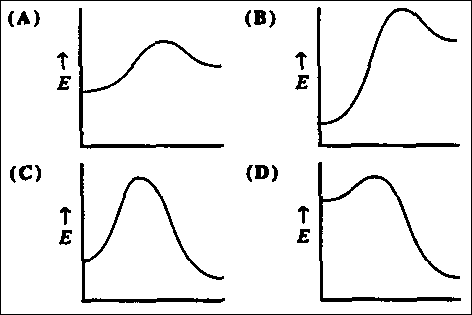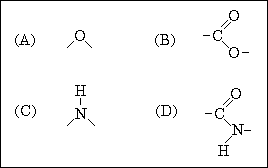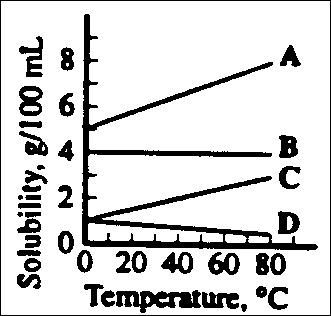U.S. National Chemistry Olympiad: 1999 Local
Section Test
Go to the answers
1. Which oxide forms a basic solution when mixed with water?
(A) K2O
(B) Al2O3
(C) CO2
(D) SO3
2. Which of these compounds is not white?
1. KMnO4
2. ZnSO4
3. FeCl3
(A) 1 only
(B) 1 and 3 only
(C) 2 and 3 only
(D) 1, 2, and 3
3. Which gas will cause a solution containing potassium iodide and starch to turn a
blue-black color?
(A) H2
(B) CO2
(C) Cl2
(D) NH3
4. A colorless aqueous solution contains a single ionic compound. Use this experimental
information to deduce the identity of the compound.
* When a small amount of dilute NaOH solution is added to the solution, a precipitate
forms. This precipitate dissolves when excess NaOH is added.
* Addition of AgC2H3O2 to the solution gives a white
precipitate.
(A) AlCl3
(B) Ba(NO3)2
(C) CuSO4
(D) FeI2
5. The most active metals on the periodic table have
(A) large radii and high electronegativities.
(B) small radii and low electronegativities.
(C) small radii and low ionization energies.
(D) large radii and low ionization energies.

6. The aqueous solubilities of several compounds between temperatures of 0 ░C and 80
░C are shown in this diagram. Which compound can be recovered with the highest percent
yield by dissolving a sample in water at 80 ░C and cooling to 0 ░C?
(A) A
(B) B
(C) C
(D) D
7. A student determines the concentration of a solution of NaOH. She pipets a sample of
the NaOH solution into a flask and adds two drops of an indicator. Standardized acid is
added from a buret until the indicator changes color. Which device may contain residual
water without affecting the results of the titration?
1. buret
2. flask
3. pipet
(A) 1 only
(B) 2 only
(C) 1 and 3 only
(D) 2 and 3 only
8. The density of a block of metal is determined by weighing it, then submerging it in
water. Based on these data, to how many significant figures should the density be
reported?
| Data |
| mass of block |
25.472 g |
| volume of H2O |
10.5 mL |
volume of H2O
with block |
20.0 mL |
(A) 2
(B) 3
(C) 4
(D) 5
9. Arsenic(III) sulfide reacts with oxygen to form arsenic(III) oxide and sulfur(IV)
oxide as represented by this equation.
__As2S3 + __O2 ---> __As2O3
+ __SO2
What is the coefficient for O2 when this equation is balanced using whole
number coefficients?
(A) 5
(B) 7
(C) 9
(D) 11
10. How many grams of MgCO3 contain 24.0 g of oxygen? (The molar mass of
MgCO3 is 84.3 g mol»1)
(A) 42.2 g
(B) 84.3 g
(C) 126 g
(D) 154 g
11. How many hydrogen atoms are present in one mole of ammonium benzoate, NH4C7H5O2?
(A) 6.0 x 1023
(B) 2.4 x 1024
(C) 3.0 x 1024
(D) 5.4 x 1024
12. Consider this balanced equation:
3 H2(g) + CO(g) ---> CH4(g) + H2O(g)
How many moles of CH4 can be obtained by reacting 2.0 mol of H2
with 2.0 mol CO according to this equation?
(A) 0.33 mol
(B) 0.67 mol
(C) 2.0 mol
(D) 3.0 mol
13. What is the molarity of the chloride ion in 250 mL of a solution containing 1.90 g
of MgCl2? (The molar mass of MgCl2 is 95.2 g mol»1
(A) 0.020 M
(B) 0.040 M
(C) 0.080 M
(D) 0.16 M
14. Consider this equation.
2 SO2(g) + O2(g) --> 2 SO3(g)
What happens to the total volume when 3.0 L of SO2 and 2.0 L of O2
react to form the maximum amount of SO3 possible from these volumes of
reactants. Assume all gases are at the same constant temperature and pressure.
(A) It decreases by 1.5 L.
(B) It decreases by 1.0 L.
(C) It increases by 0.50 L.
(D) It remains constant.
15. What is the molarity of an H2SO4 solution if 25.00 mL is
exactly neutralized by 32.63 mL of 0.164 M NaOH?
(A) 0.107 M
(B) 0.126 M
(C) 0.214 M
(D) 0.428 M
16. Which element exists as a solid at 25 ░C and one atmosphere of pressure?
(A) bromine
(B) chlorine
(C) mercury
(D) phosphorus
17. "Dry ice" is solid carbon dioxide. To which class of solids does it
belong?
(A) amorphous solid
(B) molecular solid
(C) network solid
(D) polymeric solid
18. Which of these factors affect the average kinetic energy of the molecules in a gas?
1. pressure
2. temperature
(A) 1 only
(B) 2 only
(C) both 1 and 2
(D) neither 1 nor 2
19. How does the vapor pressure of a liquid in a stoppered flask change if the quantity
of liquid is doubled?
(A) It doubles
(B) It increases slightly
(C) It decreases.
(D) It does not change.
20. What type of forces must be overcome when liquid ammonia vaporizes?
1. covalent bonds
2. dispersion forces
3. hydrogen bonds
(A) 1 only
(B) 2 only
(C) 2 and 3 only
(D) 1, 2, and 3
21. The temperature of a gas sample is increased from 50 ░C to 100 ░C. By what factor
must the pressure be changed if the volume is to be kept constant?
(A) 0.5
(B) 0.87
(C) 1.15
(D) 2.0
22. What is the molar mass of a gas that diffuses twice as fast as SO2? (The
molar mass of SO2 is 64 g mol»1)
(A) 16 g mol»1
(B) 32 g mol»1
(C) 128 g mol»1
(D) 256 g mol»1
23. How many grams of ice at 0 ░C can be melted by the addition of 500 J of heat? (The
molar heat of fusion for ice is 6.02 kJ mol»1)
(A) 0.0831 g
(B) 1.50 g
(C) 3.01 g
(D) 12.0 g
3 O2(g) --> 2 O3(g)
24. This reaction is endothermic. What can be concluded about the average energy per
bond in O2 and O3?
(A) The average energy per bond in O2 is greater than the average energy per
bond in O3.
(B) The average energy per bond in O2 is less than the average energy per bond
in O3.
(C) The average energy per bond in O2 is the same as the average energy per
bond in O3.
(D) No conclusion can be drawn about the average bond energies from this information
alone.
25. Under which set of conditions is a chemical reaction most likely to be spontaneous?
| |
DH |
DS |
T (temperature) |
| (A) |
- |
- |
low |
| (B) |
- |
- |
high |
| (C) |
+ |
+ |
low |
| (D) |
+ |
- |
high |
26. For which reaction do you expect DS to be negative?
(A) 2C(s) + O2(g) --> 2CO(g)
(B) Br2(s) --> Br2(l)
(C) H2O(l, 25 ░C) --> H2O(l, 50 ░C)
(D) Cl2(g) + 2HI(g) --> I2(s) + HCl(g)
| Reaction |
Enthalpy
Change, DH |
| Mg(s) + 2 HCl(aq) --> MgCl2(aq) + H2(g) |
-467 kJ mol»1 |
| MgO(s) + 2 HCl(aq) --> MgCl2(aq) + H2O(l) |
-151 kJ mol»1 |
27. According to this information, and given the fact that for water, DH = -286 kJ mol»1, what is DH
for MgO(s)?
(A) -904 kJ mol»1
(B) -602 kJ mol»1
(C) -334 k J mol»1
(D) -30 kJ mol»1
28. The rate of a reaction with just two reactants is observed to double when the
concentration of one reactant is doubled and the second reactant is held constant. The
rate is also observed to increase by a factor of nine when the concentration of the second
reactant is tripled, holding the concentration of the first reactant constant. What is the
overall order for this reaction?
(A) 2
(B) 3
(C) 5
(D) 6
29. Which energy diagram represents a highly exothermic reaction that has a small
activation energy? (Assume that all curves are plotted on the same scale.)

30. Tritium decays by a first-order process that has half-life of 12.5 years. How many
years will it take to reduce the radioactivity of a tritium sample to 15% of it original
value?
(A) 64 y
(B) 54 y
(C) 34 y
(D) 24 y
31. What is the overall order of a reaction with a rate constant having the units L
mol»1 s»1?
(A) 0
(B) 1
(C) 2
(D) 3
32. In a reaction with several steps, which step limits the rate of the reaction?
(A) first
(B) last
(C) fastest
(D) slowest
P4(s) + 5 O2(g) <===> P4O10(s)
33. What is the equilibrium expression for this reaction?
(A) Kc = [P4O10] / [P4] [O2]5
(B) Kc = [P4O10] / 5 [P4] [O2]
(C) Kc = [O2]5
(D) Kc = 1 / [O2}5
Fe3O4(s) + 4 H2(g) <===> 3 Fe(s)
+ 4 H2O(g)
DH > 0
34. For this reaction at equilibrium, which changes will increase the quantity of
Fe(s)?
1. increasing temperature
2. decreasing temperature
3. adding Fe3O4(s)
(A) 1 only
(B) 1 and 2 only
(C) 2 and 3 only
(D) 1,2, and 3
35. Which 0.1 M solution has the highest pH?
(A) sodium carbonate
(B) sodium chloride
(C) ammonium carbonate
(D) ammonium chloride
36. Which is the strongest acid?
(A) acetic acid - (Ka = 1.8 x 10»5)
(B) benzoic acid - (Ka = 6.3 x 10»5)
(C) formic acid - (Ka = 1.8 x 10»4)
(D) nitrous acid - (Ka = 6.0 x 10»4)
37. What is the order of concentration of the ions and molecules in a nitrous acid
solution? Nitrous acid, HNO2, is a weak acid.
(A) H3O+ = NO2» > HNO2 > OH»
(B) H3O+ = NO2» = HNO2 = OH»
(C) HNO2 > H3O+ = NO2» > OH»
(D) HNO2 > NO2» > H3O+ > OH»
38. Which acid, together with its sodium salt, would be best for preparing a buffer
with a pH = 4.5?
(A) HCN - (Ka = 4.9 x 10»10)
(B) C3H5O2H - (Ka = 1.3 x 10»5)
(C) HF - (Ka = 6.8 x 10»4)
(D) ClC2H2O2H - (Ka = 1.4 x 10»3)
39. What is the pH of a solution that contains 0.50 M sodium benzoate and 0.75 M
benzoic acid? (Ka= 6.8 x 10»5)
(A) 3.99
(B) 4.34
(C) 4.57
(D) 5.22
40. The solubility of lead(II) carbonate is 2.7 x 10»7 mol L»1.
What is its Ksp?
(A) 5.2 x 10»4
(B) 2.7 x 10»7
(C) 7.3 x 10»14
(D) 3.9 x 10»20
S4O62» + 10 H2O --> 4 SO42»
+ 20 H+ + 14 e»
41. What is the change in oxidation number of sulfur in the half-reaction?
(A) -2 to -8
(B) +4 to +1
(C) +4 to +6
(D) +2 1/2 to +6
HAsO2(aq) + Sn2+(aq) + H+(aq) -->
As(s) + An4+(aq) + H2O(l)
42. What is the oxidizing agent in the unbalanced equation?
(A) HAsO2(aq)
(B) Sn2+(aq)
(C) H+(aq)
(D) Sn4+(aq)
| Fe3+(aq) + e» ---> Fe2+(aq) |
E = +0.77 V |
| Sn2+(aq) + 2e» ---> Sn(s) |
E = -0.14 V |
43. According to the E values, what is the potential for this reaction
under standard conditions?
Sn(s) + 2 Fe3+(aq) ---> 2 Fe2+(aq) + Sn2+(aq)
(A) 1.68 V
(B) 1.40 V
(C) 0.91 V
(D) 0.63 V
44. When a sample of molten sodium chloride is electrolyzed for a given length of time,
how do the number of moles of sodium metal and chlorine gas produced compare?
(A) The moles of sodium metal are equal to the moles of chlorine gas.
(B) There are twice as many moles of sodium metal as as moles of chlorine gas
(C) There are three times as many moles of sodium metal as moles of chlorine gas.
(D) There are four times as many moles of sodium metal as moles of chlorine gas.
45. Which element has a partially-filled f subshell?
(A) Ba
(B) Eu
(C) Re
(D) Bi
46. How many orbitals have the quantum numbers n = 4 and l = 2?
(A) 1
(B) 3
(C) 5
(D) 7
47. Which element has the highest second ionization energy?
(A) Be
(B) Li
(C) B
(D) C
48. Which ion in the gaseous state has the greatest number of unpaired electrons?
(A) Ni2+
(B) Cu2+
(C) Zn2+
(D) Ge2+
49. Which property decreases crossing the periodic table from left to right and
increases from top to bottom?
(A) ionization energy
(B) electron affinity
(C) electronegativity
(D) atomic radius
50. Which compound contains both covalent and ionic bonds?
(A) calcium oxide, CaO
(B) methyl fluoride, CH3F
(C) sodium peroxide, Na2O2
(D) hypochlorous acid, HOCl
51. Which species has a Lewis structure most like that of CO32»?
(A) NO3»
(B) BCl3
(C) NCl3
(D) SO32»
52. Which element has the greatest electronegativity?
(A) As
(B) Ge
(C) P
(D) Sb
53. Which element has the highest melting point?
(A) Al
(B) Si
(C) P
(D) S
54. For which pair of species is the hybridization of the central atom the same?
(A) NH3, NH4+
(B) NO2+ , NO2»
(C) PF3, PF5
(D) BF3, BF4»
55. Arrange the species in order of decreasing H-N-H bond angle.
(A) NH2» > NH3 > NH4+
(B) NH3 > NH4+ > NH2»
(C) NH3 > NH2» > NH4+
(D) NH4+ > NH3 > NH2»
56. How many moles of water would be produced by the complete combustion of one mole of
benzene, C6H6, in excess oxygen?
(A) 2
(B) 3
(C) 4
(D) 6
57. Ketene has the formula H2C=C=O. How many sigma and pi bonds does it
have?
| |
sigma bonds |
pi bonds |
| (A) |
6 |
2 |
| (B) |
6 |
0 |
| (C) |
4 |
2 |
| (D) |
2 |
2 |
58. The prefixes used to designate organic compounds with 3 and 4 carbon atoms are,
respectively,
(A) tri- and tetra-
(B) tri- and quatr-
(C) ter- and prop-
(D) prop- and but-
59. Which functional group is characteristic of proteins?

60. Which substance is most likely to be used as a soap?
(A) CH3(CH2)12CO2CH3
(B) CH3(CH2)5O(CH2)5CH3
(C) CH3(CH2)12CO2Na
(D) CH3(CH2)12CHCl2
|